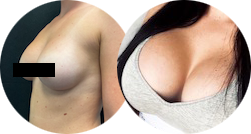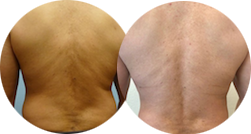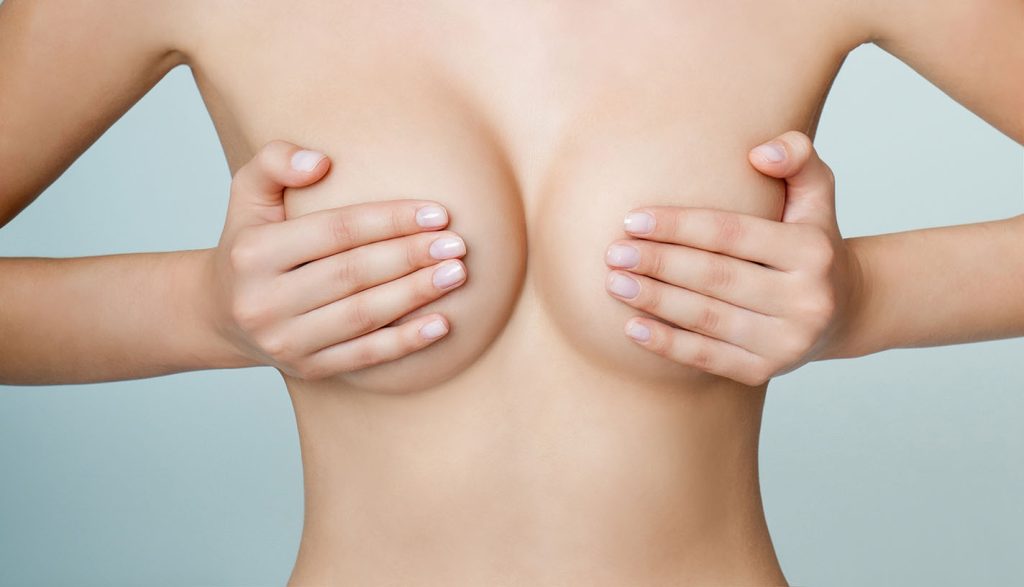When it comes to breast implants, there are a lot of choices to make. First, you need to decide what type of implant you want. There are different types of silicone implants, and other important specifications such as shape, size, and projection. You and your surgeon also need to decide how and in which layers of tissue the implant will be placed. This blog post will explain all of these choices so that you can make the best decision!
When you are ready to create your dream breasts, contact us for a consultation with double board-certified surgeon Dr. Wendie Grunberg of Alluring Aesthetics. She will work with you to tailor your breast augmentation to your specific wants and needs. Patients in San Antonio, TX, love their results after surgery with Dr. Grunberg; you will, too!
Contents
Different Implant Types
At Alluring Aesthetics, Dr. Grunberg provides different implant types that will yield the best results. These results are breasts with a natural look and feel, gorgeous cleavage, and a shape that holds up over time, which is why she offers silicone implants with or without fat grafting, and the hot new gummy bear implants.
Silicone
Silicone implants are the most popular type of implant used by surgeons today. Introduced in 1962, by the 1980s, the FDA noticed a pattern with silicone breast augmentation patients who were ill with similar symptoms. Then, in 1992, the FDA removed silicone breast implants from the market. Fourteen years later, in 2006, the FDA re-approved silicone implants, and recent advances have resulted in silicone implants that are safer than ever. Today, research is ongoing so that we can ensure that silicone implants continue to be safe for our patients. The rate of disease related to ruptured silicone implants today is minimal, and Dr. Grunberg only uses implants that are FDA-approved. [1]
A Cohesive Solution
The implants Dr. Grunberg offers her patients are pre-filled with a cohesive gel, which means there is less chance for leakage should the patient experience rupture. In addition, with silicone implants, a gel that stays in place means the silicone has less chance of migrating to other parts and causing any symptoms.
Gummy Bear
If you are looking for a very natural look and feel, gummy bear implants may be the right choice for you. These implants are made of a firm silicone gel, so they retain their shape. These implants can provide years of beautiful lift for patients with minimal skin laxity at the time of the operation. And, the firm gel allows for more dramatic projection with a smaller implant. Additionally, some implants have a textured surface, which helps them stay in place.
Fat Grafting
Dr. Grunberg has devised a unique method of combining implants and fat grafting, which creates gorgeous cleavage in patients who may end up with an unwanted gap between their breasts otherwise.
What is Capsular Contracture?
You may have heard this term used concerning implants, but what is it exactly? Capsular contracture is when the naturally-occurring capsule of scar tissue that forms around the implant begins to contract; this can cause pain and deformity, and it may require revision surgery to correct. Capsular contracture is the number one complication after breast augmentation surgery. [2]
The contraction is caused by the body’s inflammatory reaction to the implant. Just as your immune system attacks a virus, it will also attack something it perceives as foreign, like an implant. As a result, the body forms a capsule of scar tissue around the implant to protect itself, and as it continues to grow and tighten, sometimes this capsule will contract. Capsular contracture can happen with any implant. Capsular contracture is usually caused by bacteria colonizing the implant pocket. [2] Board-certified surgeons like Dr. Grunberg use a combination of preventative techniques to reduce this risk during surgery.
Projection
There are other considerations for your implant choice! The profile or projection of your implant is how far it extends from your chest, measured in millimeters. A higher-profile implant will have a smaller diameter and more projection. A lower profile implant will have a larger diameter and provide less projection. The right choice for you will depend on your desired look and the width of your chest.
Helpful Tips
Here are some tips Dr. Grunberg uses to assist her patients in finding their ideal implant:
- Photo References – You can bring in pictures of what you would like your breasts to look like, and Dr. Grunberg will help you find an implant that will give you that look.
- Sizers – Sizers are like training wheels for your breast augmentation. These temporary implants can be placed during your consultation to get a feel for what your new breasts will look and feel like.
- Visualization – Dr. Grunberg will use state-of-the-art technology to give you a visualization of your new breasts. You can also look through our before and after photos before your appointment.
- The Right Fit – Dr. Grunberg will make sure that your implants are the right fit for your body, and she will also be there for you every step of the way to ensure you are happy with your results.
There are many factors to consider when choosing breast implants, but with the help of a skilled and experienced plastic surgeon like Dr. Grunberg, you are sure to find the perfect implants for you.
If you have any questions or would like to schedule a consultation, please call our office at (210) 714-5390.
How Big Should I Go?
Another consideration with implants is the volume, meaning how many cc’s of gel is inside the implant. A general rule of thumb is that one cup size corresponds to about 200-250ccs, but this is not always the case, depending on how much breast tissue you already have, and the type of implant you’re considering. So again, Dr. Grunberg will help you choose the correct size.
At Home Experimentation
Here’s a fun method to measure cc’s at home using uncooked rice. First, take a ziplock bag or nylon stocking and put in the amount of rice you think corresponds to your desired volume. For example:
- 1/8 cup rice = 30 cc.
- 1/4 cup rice = 59 cc.
- 1/3 cup rice = 78 cc.
- 1/2 cup rice = 118 cc.
- 2/3 cup rice = 156 cc.
- 3/4 cup rice = 177 cc.
- 1 cup rice = 236 cc.
Once you have your desired amount of rice, put the bags in the cups of your bra — or the bra you hope to wear after surgery — and take them for a test drive. While this is a fun way to get an idea of implant size, remember, it’s not exact. Ultimately, it’s up to you and Dr. Grunberg to choose the right size for your body and your desired look.
Lifestyle Influence
Your current lifestyle is one of the most overlooked factors when selecting implant size. You may want to choose a smaller implant if you are active and enjoy high-impact activities like running or cross-training. The larger the implant, the greater the movement. Patients planning to become pregnant may also want to consider waiting until after they are done breastfeeding.
Another consideration is your current age in terms of skin laxity. If you are younger, your skin will likely have more elasticity and be able to accommodate a larger implant. However, if you are older or have had children, you may want to choose a smaller implant to avoid stretching your skin.
Remember, where there’s a will, there’s a way. If you can dream it, Dr. Grunberg can achieve it!
Implant Placement: Submuscular vs. Subglandular
If you’ve decided which implant will work best for your augmentation, the next decision you and Dr. Grunberg will need to make is where you want your implants placed. Implants can be placed either in a submuscular or subglandular position.
Submuscular implants are placed underneath the chest muscle, which offers more support for the implant and can help to camouflage the edges of the implant and prevent rippling. It can help create a more natural look and feel because more of the patient’s breast tissue is above the muscle. The downside of this method is that it requires a larger incision and can take longer to recover from surgery.
Subglandular implants are placed underneath the breast tissue but above the chest muscle. This method is less invasive and has a shorter recovery time. When the implant is subglandular, less tissue covers it, making rippling more visible. This method is less ideal for patients with very little of their own breast tissue.
Incision Type: Inframammary vs. Periareolar
Now is the time to consider where Dr. Grunberg will make your incisions for breast implant access. There are two main types of incisions: inframammary and periareolar.
Inframammary incisions are made in the crease underneath the breast; this is the most common type of incision for breast augmentation surgery. It gives the surgeon excellent access to the implant pocket and more control over the final placement of the implants.
Periareolar incisions are made along the border of the areola (the colored part around the nipple). This incision is less common but can be a good option for patients with very little breast tissue, or who are having a smaller implant placed.
The Bosom Line
The bottom line is this: breast implants are a big decision. But you don’t have to make it alone. Dr. Grunberg and her team are here to help you every step of the way. From implant selection to incision type, we will work with you to ensure you get the desired results. So schedule a consultation today to get started! Patients in San Antonio, TX, and the surrounding areas can call (210) 714-5390 to speak with our scheduling coordinator.
References
- Kaplan J, Rohrich R. Breast implant illness: a topic in review. Gland Surgery. 2021;10(1):430-443. doi:10.21037/gs-20-231
- 231. Adams WP. Capsular Contracture: What is It? What Causes It? How Can It Be Prevented and Managed? Clinics in Plastic Surgery. 2009;36(1):119-126. doi:10.1016/j.cps.2008.08.007





